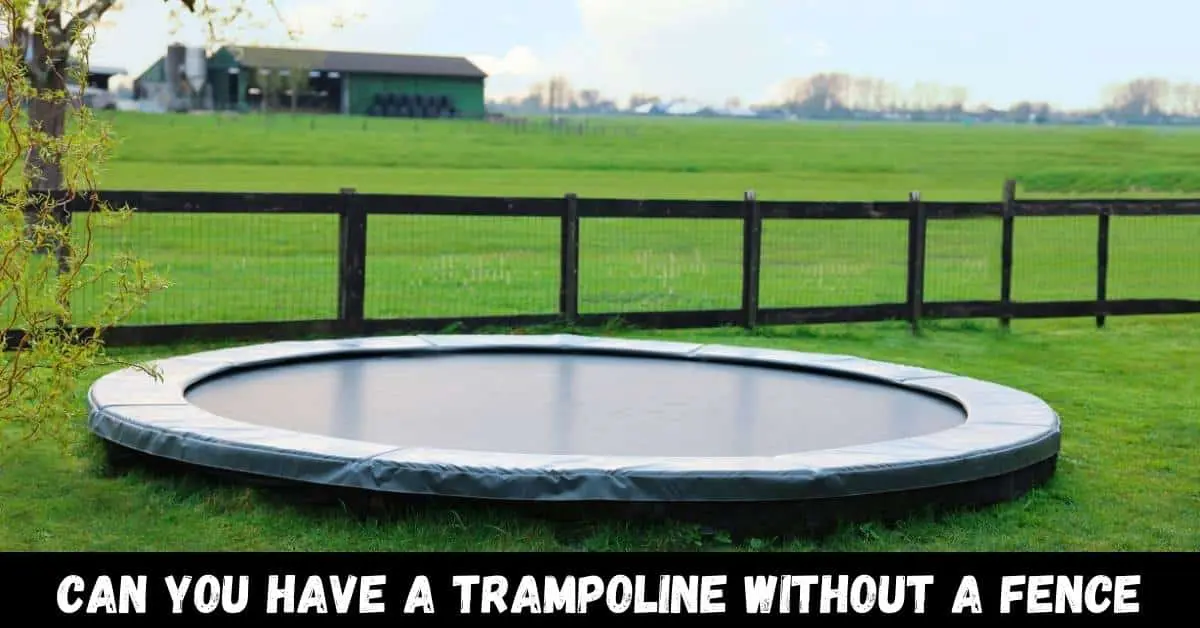Can you have a trampoline without a fence? Trampoline fence laws in the United States can vary depending on the state, city, and county you reside in. Generally, no federal law mandates the installation of a fence around a trampoline before its use.
However, it is important to note that local authorities, both at the city and county levels, have the autonomy to establish regulations concerning recreational activities.
To determine if there are any specific trampoline fencing laws in your area, it is advisable to contact your local authorities or consult a lawyer specializing in local regulations.
They can provide you with accurate information regarding any existing laws or requirements related to trampoline safety measures, including the necessity of a fence.
Remember, prioritizing safety is crucial when it comes to trampoline usage. Even if there are no legal obligations to install a fence, it is recommended to implement other safety measures such as adult supervision, safety padding, and establishing clear rules for safe jumping practices.
Can you Have a Trampoline Without a Fence: Yes, you can have a trampoline without a fence. While no federal laws require a fence, local regulations may vary. Check with your local authorities for specific requirements.
Can You Have a Trampoline Without a Fence?
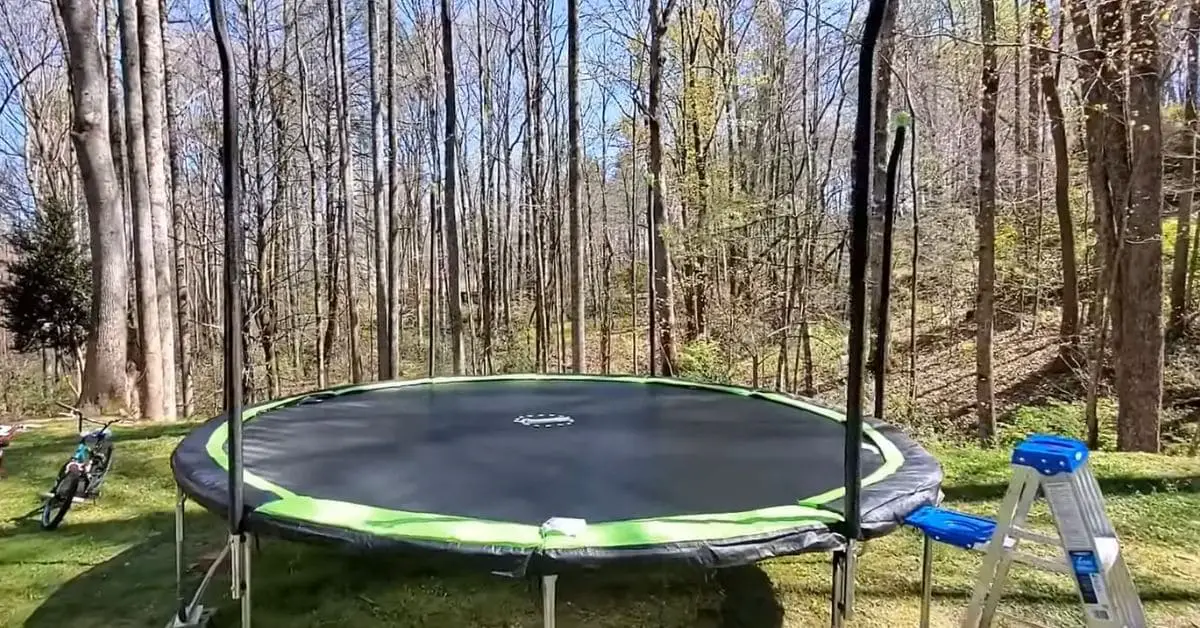
Whether or not you can have a trampoline without a fence largely depends on where you live and how strict your local or state government is. Generally, it is permissible to have a trampoline without a fence in most cases.
However, it’s important to note that insurance companies may have their requirements. Many insurance companies will not provide liability or personal injury coverage if you do not have a fence around your trampoline.
So, even if there are no specific regulations from your city, county, or state, your insurance company may still insist on a fence for coverage.
To ensure you have the appropriate coverage and comply with any insurance requirements, it’s advisable to check with your insurance provider and understand their policies regarding trampolines and fencing.
This will help you make informed decisions about the safety measures you need to have in place.
Trampoline Distance From Fence Limit?
In some jurisdictions, trampolines are not considered accessory structures but rather mobile play structures. This means there are usually no specific rules or regulations regarding where you can place a trampoline in your backyard.
In one instance, a city in California attempted to classify trampolines as accessory structures, but they ultimately concluded that they couldn’t regulate them through city ordinances.
However, if you live in a home that is part of a Homeowners Association (HOA), it’s important to check the HOA’s bylaws. They may have their regulations regarding trampoline placement. You can file a complaint with your HOA if these regulations are violated.
What regulations or rules apply to trampoline parks?
Trampoline parks are popular recreational facilities where kids can enjoy jumping and performing tricks on trampolines. These parks can be indoors or in large open areas, allowing kids to enjoy fresh air while having fun.
However, it’s important to note that only Arizona and Michigan have specific trampoline safety laws that govern the operation of these trampoline parks. In all other states, the industry relies on safety standards established by the International Association of Trampoline Parks (IATP).
These standards focus on ensuring customer safety rather than regulating the businesses operating the parks. Some of these standards include using plexiglass fencing around the trampolines or having no hole netting surrounding them.
There should be no obstructions near the area where customers dismount, and all hard surfaces should be covered in foam padding. Additionally, there should be one monitor for every 32 customers to ensure proper supervision.
Trampoline Height Exceeding Fence Level
When it comes to placing a trampoline in your yard that is taller than your fence, there are generally no specific city or county laws prohibiting it. However, it’s important to consider the safety implications of having a higher trampoline.
Having a trampoline taller than your fence can pose safety risks, so it’s advisable to review your homeowner’s insurance policy to ensure you have coverage for accidents or injuries that may occur while using the trampoline.
If you live in a Housing Authority, bylaws may be in place that restrict the height of structures above the fence line. Additionally, it might be worth checking if your city has any neighborhood laws regarding this matter.
Currently, there are no widespread restrictions on trampolines being taller than fences.
What should I do if I have a trampoline positioned next to my fence?
When your neighbor places their trampoline next to your fence, you have a few options to consider. It’s important to handle the situation in a way that avoids unnecessary trouble and maintains a good relationship with your neighbor.
Here are some options you can explore:
- Consult with a lawyer: Find out if there are any laws or regulations regarding the placement of trampolines in your area. A lawyer can guide you on your rights and potential courses of action.
- Check city guidelines: Contact your city authorities to see if any neighbor laws or regulations specifically address trampoline placement. This information can help you understand your options within the legal framework.
- Communicate with your neighbor: Have a conversation with your neighbor and kindly discuss your concerns. See if they would be willing to relocate their trampoline to a different area that minimizes any potential issues.
- Contact their landlord (if applicable): If your neighbor is renting their property, reach out to their landlord and inform them about the situation. The landlord may have their own policies or insurance concerns that could prompt them to address the trampoline placement.
- Review your insurance coverage: Speak with your insurance agent to determine if you have sufficient coverage for any injuries or accidents that may occur due to the neighbor’s trampoline. Understand the extent of your protection and consider any necessary adjustments to your policy.
- Enhance privacy or security: If relocating the trampoline is not feasible, you can install screens or raise your fence to maintain privacy and mitigate any potential disturbances.
Remember, it’s crucial to approach the situation calmly and respectfully, seeking mutually beneficial solutions whenever possible.
Advantages and Disadvantages of Having a Fence for a Trampoline
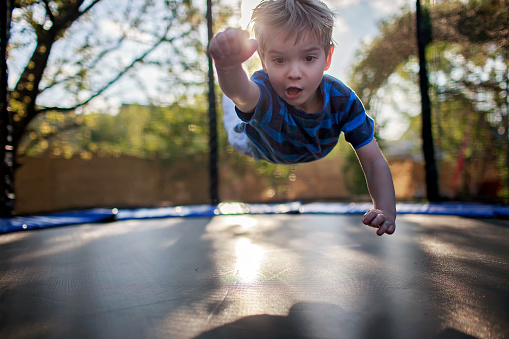
Trampolines offer enjoyable outdoor fun and exercise for individuals of various ages. However, safety is crucial when using them.
One important safety consideration is whether or not to have a fence around the trampoline.
In this article, we will explore the advantages and disadvantages of having a fence for a trampoline.
Fence around a Trampoline: Benefits
- Protection from external factors: A fence also offers protection for the trampoline itself. It acts as a barrier against elements like wind, rain, and sun, which can potentially damage the trampoline and shorten its lifespan. The fence provides an additional layer of protection, helping to preserve the trampoline for longer use.
- Safety: One of the main benefits of having a fence around a trampoline is ensuring safety. It helps prevent accidents by keeping children and pets from accidentally falling off the trampoline, reducing the risk of injuries.
- Peace of mind: Having a fence around the trampoline can give parents peace of mind. They can feel more at ease knowing that their children can enjoy the trampoline safely without the constant worry of them falling off.
- Privacy: Another advantage of having a fence around the trampoline is increased privacy. It can shield your family’s trampoline activities from prying eyes and provide a more secluded space for jumping and having fun without unwanted attention from neighbors or passersby.
Drawbacks of Having a Fence Around a Trampoline
- Limited space: A fence around a trampoline can restrict the space for other activities or items in your yard. This can be especially problematic if you have a small backyard and need to maximize the usable area.
- The difficulty of assembly: Installing a fence around a trampoline can be challenging and time-consuming. If you’re not skilled in DIY projects or using tools, it may be difficult to assemble the fence correctly, adding extra effort and potential frustration.
- Cost: One of the disadvantages of having a fence around a trampoline is the additional cost it brings. Buying and installing a fence can increase the overall expenses, which may not be affordable for everyone.
- Aesthetics: Another drawback is that a fence can affect your backyard’s or outdoor area’s visual appeal. Some homeowners may find that the presence of a fence takes away from the overall appearance of their space.
Arguments for Having a Fence
Here are some arguments for having a fence:
Prevention of Accidental Falls:
Placing a fence around the trampoline is a physical barrier that effectively prevents users, particularly children, from accidentally falling off the trampoline. This safety measure significantly reduces the risk of injuries and brings peace of mind to parents and caregivers.
Containment of Users within the Trampoline Area:
The presence of a fence ensures that users remain within the designated trampoline area while they jump and play. This containment helps prevent accidents or collisions with objects located outside the trampoline space, ensuring a safer and more controlled environment for trampoline activities.
Protection Against Collisions with External Objects:
A fence acts as a protective barrier by creating a buffer zone around the trampoline. It effectively safeguards users from colliding with external objects like trees, bushes, or nearby structures.
This protection minimizes the risk of injuries and potential damage to both users and the trampoline itself, promoting a safer and more enjoyable trampoline experience.
Having a fence around the trampoline offers multiple advantages, including preventing accidental falls, containing users within the designated area, and protecting against collisions with external objects.
These benefits enhance safety, minimize risks, and contribute to a positive trampoline experience.
Arguments Against Having a Fence
Here are some other arguments against having a fence:
Unobstructed Access and Ease of Entry:
Not having a fence around the trampoline allows users to easily access and exit the trampoline without any physical barriers. This can be particularly beneficial for younger children or individuals with mobility challenges, as it eliminates the need to navigate through a gate or climb over a fence.
It promotes a sense of freedom and convenience, making the trampoline more accessible and enjoyable.
Enhanced Visibility and Monitoring of Users:
The absence of a fence provides a clear line of sight for parents, caregivers, or supervisors to monitor users’ activities on the trampoline.
With unobstructed visibility, they can closely observe the users’ movements, ensure they follow safety guidelines, and promptly address any potential safety concerns or risky behaviors. This real-time monitoring can contribute to a safer trampoline experience.
Flexibility and Space Constraints:

Not having a fence offers more flexibility regarding trampoline placement and configuration.
It allows for easier adjustments or repositioning of the trampoline to better utilize the available space in the backyard or outdoor area.
This flexibility can be particularly advantageous if the space is limited or if some other outdoor activities or structures need to coexist in the same area.
Having an open trampoline area without a fence provides advantages such as unobstructed access and easy entry, enhanced visibility for effective monitoring, and greater flexibility in terms of space utilization.
These factors can contribute to a more convenient and adaptable trampoline setup catering to users’ specific needs and preferences.
However, it is important to carefully consider the potential safety risks and take appropriate measures to ensure the well-being of trampoline users in the absence of a fence.
Personal Assessment and Decision-Making
Making a personal assessment and deciding whether to have a fence around a trampoline requires considering various factors and weighing the pros and cons. Here are some steps to help you in the decision-making process:
Evaluating the Specific Circumstances and Environment:
Take a close look at your specific circumstances, including the yard layout, potential hazards, and the age and behavior of trampoline users. Assess the risks and challenges you may face to determine if a fence would benefit your situation.
Weighing the Benefits and Drawbacks of a Fence:
Consider the benefits discussed earlier, such as increased safety, containment of users, and protection against collisions. Evaluate how these benefits align with your priorities and concerns.
Additionally, consider the drawbacks, including the cost, the potential impact on aesthetics, limited space, and installation difficulty. Determine if these drawbacks outweigh the benefits or if there are alternative measures you can take to mitigate the risks.
Seeking Professional Advice and Considering:
Consult with professionals such as trampoline safety experts, landscapers, or even your insurance provider. They can provide valuable insights and guidance based on their expertise. Additionally, consider your preferences and those of your family.
Consider factors such as the age of trampoline users, the level of supervision available, and your comfort level with potential risks.
By thoroughly evaluating the circumstances, weighing the benefits and drawbacks, seeking professional advice, and considering individual preferences, you can decide whether to have a fence around your trampoline.
Remember, the ultimate goal is to ensure the safety and enjoyment of everyone using the trampoline while considering your situation’s specific needs and constraints.
Trampoline Safety Guidelines for No Fences
Trampolines are a fun way to play and exercise outdoors, but they can also be dangerous, especially if no fence surrounds them. Taking safety precautions to protect yourself and others while using a trampoline without a fence is important.
By following some simple guidelines, you can enjoy jumping on the trampoline while reducing the chances of accidents and injuries.
Supervision: Ensuring Trampoline Safety
The use of a trampoline, especially without a fence, requires constant adult supervision. Children should never use a trampoline alone or without an adult present. It is important to have a responsible adult supervising to make sure the trampoline is used properly and safely.
Safety Tips for Using a Trampoline:
Tips for Using a Trampoline Safely:
- Avoid flips or somersaults: It’s best to discourage doing flips or somersaults on the trampoline, especially when no fence exists. These moves can be dangerous and increase the risk of injuries.
- Regular maintenance: Inspect the trampoline for any signs of wear and tear. Check the springs and jumping mats to ensure they are in good condition and damage-free.
- Proper assembly: Ensure that the trampoline is assembled correctly and securely. Make sure the legs are placed on a flat surface and are level. Check that the springs are in good condition and tightly attached to the frame.
- Limit the number of users: Allow only one person to use the trampoline at a time. Avoid overcrowding the trampoline to reduce the chances of collisions and accidents.
- Read the manual: Before using the trampoline, read the instructions provided by the manufacturer. This will help you understand how to properly assemble, use, and care for the trampoline.
By following these safety tips, you can enjoy using the trampoline safely and minimize the risk of injuries, even without a fence.
Recommended Age Range for Trampoline Usage:
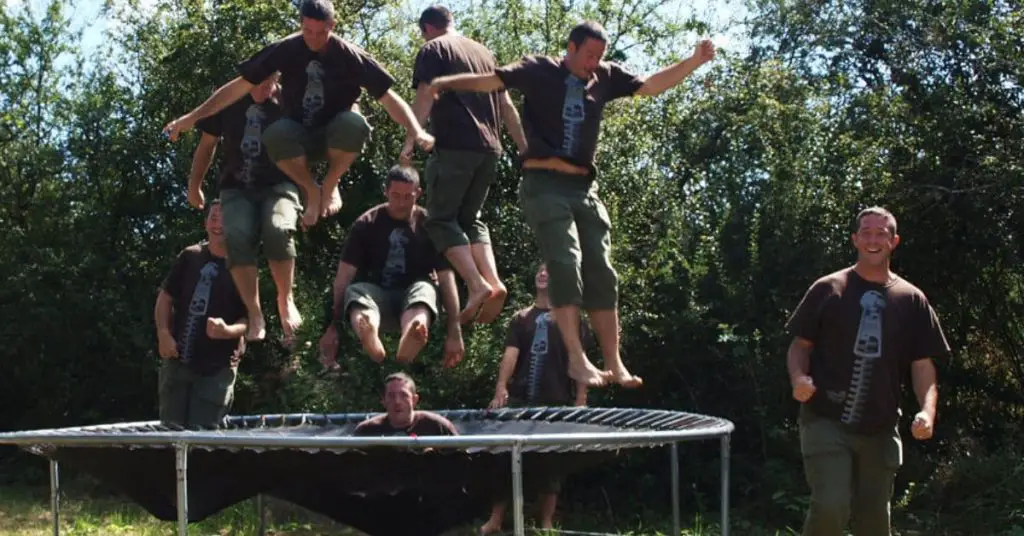
Trampoline usage is not recommended for children under the age of six, according to the American Academy of Pediatrics (AAP).
Younger children are not fully developed and may not have the skills to handle the potential risks of trampoline jumping.
If you decide to allow younger children to use a trampoline, it is essential to have adult supervision at all times. Older children who can follow safety guidelines and use the trampoline responsibly can be allowed to use it under proper supervision.
Important Legal and Insurance Factors to Consider
Trampolines can provide families with fun and exercise but also carry some risks. Injuries related to trampolines have increased, leading homeowners to question if they can have a trampoline without a fence.
In this section, we will discuss the legal and insurance factors that trampoline owners should consider before deciding whether or not to install a fence.
Insurance and No Fence Implications:
Homeowners’ insurance policies usually require trampolines to be fenced in because they can attract people to use them. If a trampoline owner does not have a fence and someone gets hurt while using it, their insurance company may not cover the cost of the claim.
The homeowner would then have to pay for any damages. Even if the policy does not specifically require a fence, the lack of one could still make the insurance policy more expensive due to the higher risk.
Liability Risks for Trampoline Owners:
Trampolines can cause serious injuries, including broken bones and spinal cord injuries. You could be held responsible if someone gets hurt while using your trampoline, even if they weren’t invited to use it.
This is called the “attractive nuisance doctrine,” which applies to things like trampolines and swimming pools.
Trampoline owners should take safety measures like installing safety nets and pads and supervising trampoline use to reduce liability risks. Adding liability insurance to your homeowners’ policy is also a good idea, which can help cover costs if someone gets injured on your trampoline.
The Trampolining Skirt:
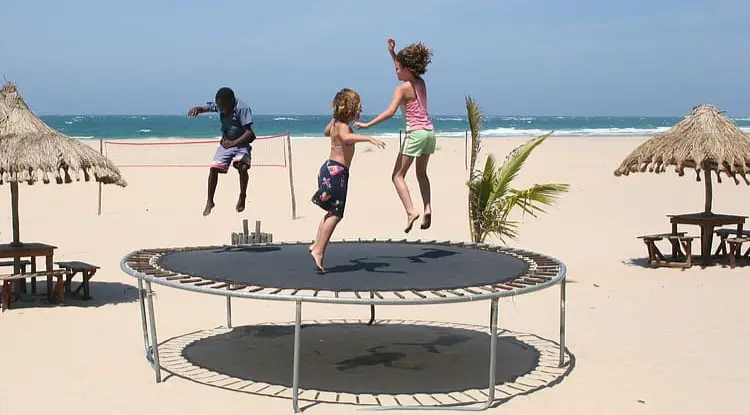
Here are some benefits and drawbacks of trampolining skirts:
Benefits of Using a Trampoline Skirt:
- Prevents users from crawling under the trampoline: A trampoline skirt acts as a barrier, preventing people from crawling or accessing the area underneath the trampoline. This adds an extra safety layer and helps keep users within the designated jumping area.
- Keep debris and animals out from under the trampoline: By installing a trampoline skirt, you can prevent debris like leaves, sticks, and other unwanted items from accumulating. It also serves as a deterrent for animals, preventing them from making a home or hiding beneath the trampoline.
- Easy to install and maintain: Trampoline skirts are designed to be user-friendly and straightforward to install. They often come with clear instructions and require minimal effort to set up. Additionally, maintenance is typically simple, involving periodic cleaning and inspections for any damage or signs of wear.
Drawbacks of Using a Trampoline Skirt:
- Does not prevent falls off the trampoline: While a trampoline skirt provides protection underneath the trampoline, it does not prevent users from falling off it. It’s important to implement additional safety measures, such as adult supervision and safety enclosures, to reduce the risk of falls.
- Can be damaged by harsh weather conditions: Trampoline skirts are exposed to the elements and may be susceptible to damage caused by severe weather conditions like strong winds, heavy rain, or extreme temperatures. Regular inspection and timely repairs or replacements may be necessary to maintain their effectiveness.
- May need to be replaced over time due to wear and tear: Trampoline skirts may experience wear and tear from regular use and exposure to outdoor elements. Depending on the quality of the skirt and the frequency of use, it may require replacement to ensure continued functionality and safety.
Benefits and Drawbacks of Using a Trampoline Enclosure Net:

Here are some benefits and drawbacks of using a trampoline enclosure net:
Benefits:
- Enhanced safety: The trampoline enclosure net offers a significant level of safety by preventing users from accidentally falling off the trampoline, reducing the risk of injuries.
- Easy installation and maintenance: Setting up and maintaining the trampoline safety net is simple, making it convenient for trampoline owners.
- Versatile fit: The net comes in various sizes, allowing it to accommodate different trampoline models and sizes, ensuring a proper and secure fit.
Drawbacks:
- Limited protection against high jumps: While the safety net helps prevent falls, it may not provide complete protection if users jump high enough to clear the net, increasing the risk of potential accidents.
- Susceptible to weather damage: Harsh weather conditions, such as strong winds or heavy rain, can potentially damage the trampoline safety net, reducing its effectiveness and requiring repairs or replacement.
- Wear and tear over time: Continuous use and exposure to outdoor elements can lead to wear and tear on the safety net, necessitating replacement to maintain its optimal functionality and safety.
Trampoline Anchors: Securing Your Trampoline:
Here are some benefits and drawbacks of trampoline anchoring:
Benefits:
- Stability: Trampoline anchors offer stability during use, ensuring the trampoline remains steady and balanced. This reduces the risk of accidents and provides a safer jumping experience.
- Wind and Weather Protection: Trampoline anchors help prevent it from tipping over during high winds or stormy weather by securely anchoring the trampoline to the ground. This safeguard ensures the trampoline stays in place, even in challenging weather conditions.
- Ease of Installation and Maintenance: Trampoline anchors are designed to be user-friendly, making them easy to install and maintain. With simple instructions and minimal effort, you can set up the anchors and keep them in good working condition.
Drawbacks:
Falls Prevention: While trampoline anchors provide stability, they do not prevent falls off the trampoline. Users should still be cautious and follow safety guidelines to avoid injuries.
Effectiveness on Soft Ground: Trampoline anchors may be less effective in areas with soft ground, such as sandy or muddy terrain. The ground may not support the anchors sufficiently, compromising their stability.
Replacement Over Time: Trampoline anchors, like any equipment, may experience wear and tear over time. Depending on usage and environmental factors, they may require replacement to maintain their effectiveness and ensure continued safety.
FAQs:
Q:1 Is it safe to have a trampoline without a fence?
While a fence is not mandatory for a trampoline, it is strongly recommended for safety reasons. A fence helps prevent accidental falls off the trampoline, reducing the risk of injuries.
Q:2 Are there any alternatives to a fence for trampoline safety?
If you choose not to have a fence, there are alternative safety measures you can take. One option is to place the trampoline in a dedicated, enclosed area away from hazards. Additionally, using safety pads to cover the springs and ensuring proper adult supervision can enhance safety.
Q:3 What are the risks of not having a fence for the trampoline?
The main risk of not having a fence is an increased chance of falling off the trampoline, potentially resulting in injuries such as sprains, fractures, or even more severe harm if the person lands on a hard surface.
Q:4 Can I rely solely on adult supervision instead of a fence?
While adult supervision is important, it should not be considered a substitute for a fence. Accidents can happen quickly, and a fence provides an added layer of protection even when adults are present. Combining supervision with a fence is the best approach for trampoline safety.
Q:5 Are there any specific guidelines for trampoline safety without a fence?
Without a fence, it is crucial to follow general trampoline safety guidelines. These include limiting the number of jumpers, ensuring the trampoline is in good condition, regularly checking for wear and tear, and providing adequate cushioning around the trampoline.
Q:6 Can I add a net enclosure to an existing trampoline without a fence?
You can install a net enclosure on an existing trampoline without a fence. A net enclosure provides an additional safety measure by preventing users from falling off the trampoline. Ensure the net is securely attached and properly maintained.
Q:7 Should I consider purchasing a trampoline with an integrated safety enclosure instead?
If safety is a priority and you do not want to rely on a separate fence or net enclosure, purchasing a trampoline with an integrated safety enclosure is wise. These trampolines come with built-in safety features that provide users with a higher level of protection.
Conclusion:
In conclusion, while having a trampoline without a fence is possible, it is crucial to carefully consider the safety implications. A fence is an effective barrier that helps prevent accidental falls off the trampoline, reducing the risk of injuries.
Although alternatives such as placing the trampoline in an enclosed area or using safety pads and adult supervision can enhance safety to some extent, they cannot fully replace the protective benefits of a fence.
Choosing not to have a fence for a trampoline increases the chances of falling off the trampoline, potentially resulting in various injuries.
To ensure the well-being of trampoline users, it is advisable to follow general trampoline safety guidelines, limit the number of jumpers, regularly inspect the trampoline for any wear and tear, and provide adequate cushioning around the trampoline.
If you decide to forgo a fence, consider installing a net enclosure on the trampoline or opting for a trampoline with an integrated safety enclosure. These options provide an additional layer of protection.
Remember, prioritizing safety should always be the primary concern when enjoying the exhilarating experience of a trampoline.
After reading this comprehensive article, we hope you will be well aware of whether you can have a trampoline without a fence. If you have any questions, feel free to comment below!

